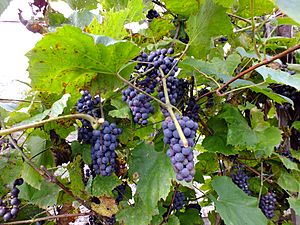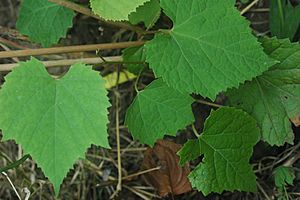Amur grape facts for kids
Quick facts for kids Amur grape |
|
|---|---|
 |
|
| Scientific classification | |
| Genus: |
Vitis
|
| Species: |
amurensis
|
The Amur grape (scientific name: Vitis amurensis) is a special type of grape. It grows naturally in parts of Asia, especially near the Amur River in Russia and China. This is where it gets its name!
This grape is super tough! It can handle very cold weather, even freezing temperatures. However, it doesn't like very dry places. Amur grapes are also good at fighting off some common plant diseases like anthracnose and ripe rot. They are also quite resistant to downy mildew and powdery mildew.
Contents
Where Amur Grapes Grow
The Amur grape is a very old plant, a leftover from warmer times before the ice ages in the Far East. It can grow quite far north, up to places like Lake Kizi in Russia. Along the coast of the Sea of Japan, it grows north to the Muli river. In the Amur region, it reaches the Zeya River.
You can find Amur grapes growing in the forests of Manchuria, Amur Oblast, and Primorsky Krai in Russia. They also grow in North East China (in areas like Anhui, Hebei, Heilongjiang, Jilin, Liaoning, Shandong, Shanxi, and Zhejiang) and in Korea.
Amur grapes are divided into three main types, called subspecies:
- V. amurensis var. amurensis
- V. amurensis var. dissecta
- V. amurensis var. yanshanensis
These grapes are most common in river valleys and along streams. They also like clearings, forest edges, and mountain slopes. They climb up trees and spread along the ground. The Amur grape is the toughest type of grape that grows in the cold taiga forests of the Far East.
Most grape types need much warmer weather. But the Amur grape is special because it can survive winter temperatures as low as −45 °C! Even its roots can handle soil temperatures down to −16 °C.
Sadly, human activities have caused the number of Amur grapes in the wild to decrease. Their natural growing areas have become smaller.
What Amur Grapes Look Like
The Amur grape is a Liana, which is a type of woody vine. Its main stem can be 5–10 cm thick. These vines can spread very far, usually 15–18 meters, and sometimes even up to 20–25 meters! They have special parts called Tendrils that wrap around branches or anything else they can find to help them climb.
The bark on older parts of the vine is dark and scaly, with vertical stripes. Younger shoots are green, sometimes with a reddish color, and turn reddish-brown in autumn.
The leaves of the Amur grape come in many shapes. They can be solid, or have three or five lobes (like fingers). They are usually oval or rounded, and their edges have sharp, jagged teeth. The leaves are quite large, from 9 to 25 cm across. The top surface of the leaves is smooth. In autumn, the leaves turn beautiful bright colors like red, yellow, orange, and brown.
The flowers are small and provide nectar for bees. In their natural home, they usually appear in the second week of May.
Amur grape plants usually have separate male and female plants (this is called dioecious). But sometimes, you might find a plant that has both male and female parts (called hermaphrodite).
The fruits of the Amur grape are round and can be black or purple, sometimes dark blue. They can taste very sour or quite sweet. Each berry is usually up to 12 mm wide and has a thick skin. The fruit can have a lot of sugar, up to 22-23%. In the wild, they ripen in late September. The inside of the berries is juicy. The bunches of grapes can be large, similar to the number of berries in other grapes. Sometimes, a bunch can be up to 25 cm long and weigh 250 grams, though they usually weigh 20-70 grams.
How Amur Grapes Are Used
Amur grapes are often used as an ornamental plant. People grow them to climb walls or trellises in gardens, even as far north as St. Petersburg in European Russia. They are also very important for creating new types of grapes. People cross Amur grapes with other grape species (like Vitis vinifera, the common wine grape) to make new varieties that can survive cold weather and ripen early. These new grapes are great for making wine and for eating in cold climates.
These grapes can also handle city conditions well, like smoke, dust, and pollution.
Amur grapes need a good amount of rain, about 700 mm per year. So, they don't grow well in dry places unless they get extra water. They are perfect for wetter areas that are usually too cool for grapes, such as North West Europe, Northern Russia, and the Pacific Northwest. They are quite resistant to diseases, ripen early, and are suited for short growing seasons. They also have some protection against a tiny insect called phylloxera that can harm grapevines.
When they are fully ripe, Amur grapes can be eaten raw and are sweet. If they are not fully ripe, they can be sour and bitter. People often use them to make wine, juice, jellies, and jams. The leaves can even be used in salads!
Amur grapes are also good at resisting some types of mildew. They grow very fast, about 2.5 meters each year. Amur grape plants usually start to flower and produce fruit around their fifth year. They prefer loose, acidic soil and don't like too much lime (a type of mineral). Adding acidic peat to the soil helps them grow better. They produce the most fruit when they get a lot of sunlight.
Many grape varieties grown in northern vineyards today are crosses with Amur grapes. Some examples include 'Arctic', 'Buytur', 'Dawn of the North', 'Currants Michurin', 'Metal', 'Russian Concorde', 'North', 'Black North', and 'Kurinka Russkaja'. Some important hybrid grapes with Amur grape ancestors grown in Western Europe are "Zarya severa", Severny, and Rondo.
History of Growing Amur Grapes
In the past, scientists in the former USSR studied Amur grapes to understand how they resist cold. They created new types of grapes by crossing Amur grapes with other types like V. vinifera or V. labrusca.
The first time Amur grapes were grown on a large scale for wine was during the Japanese occupation of Manchuria (1931-1945). In Jilin, northeast China, the Japanese started the first wineries that made wine from wild Amur grapes.
About 800 km south, in the Beijing region, European grapes (V. vinifera) can only grow if their vines are buried under thick layers of earth in winter to protect them from extreme cold. Because of this difficulty, the Japanese decided to use the very cold-resistant wild Amur grape to make wine. In 1936, the Changbaishan Winery Ltd was started, followed by Tonghua Winery Ltd in 1938. These were in the Jilin region, near the North Korean border. This area has long, cold winters and short, warm summers. In January, the average temperature can be between -14 to -20 °C. At that time, the Changbaishan winery produced 40 tons of wine.
In 1954, the Beijing Botanical Garden tried crossing Amur grapes with European grapes. But a big step forward happened in 1965, when a wild Amur grape plant with both male and female parts was found in the mountains near the Changbeishan winery.
After this discovery, agricultural research centers in the Jilin region started programs to improve the Amur grape. They wanted to use its genes for cold resistance. They worked on making better types of Amur grapes by crossing them with each other and also by crossing them with the best European grape varieties.
The first hybrid grapes were found to have less sugar and more acidity than European grapes. However, further crosses have made them much better. Many crosses were also made in Russian research stations to create new grape varieties that are resistant to cold and mildew.
Images for kids
- Vitis amurensis
See also
 In Spanish: Vitis amurensis para niños
In Spanish: Vitis amurensis para niños




